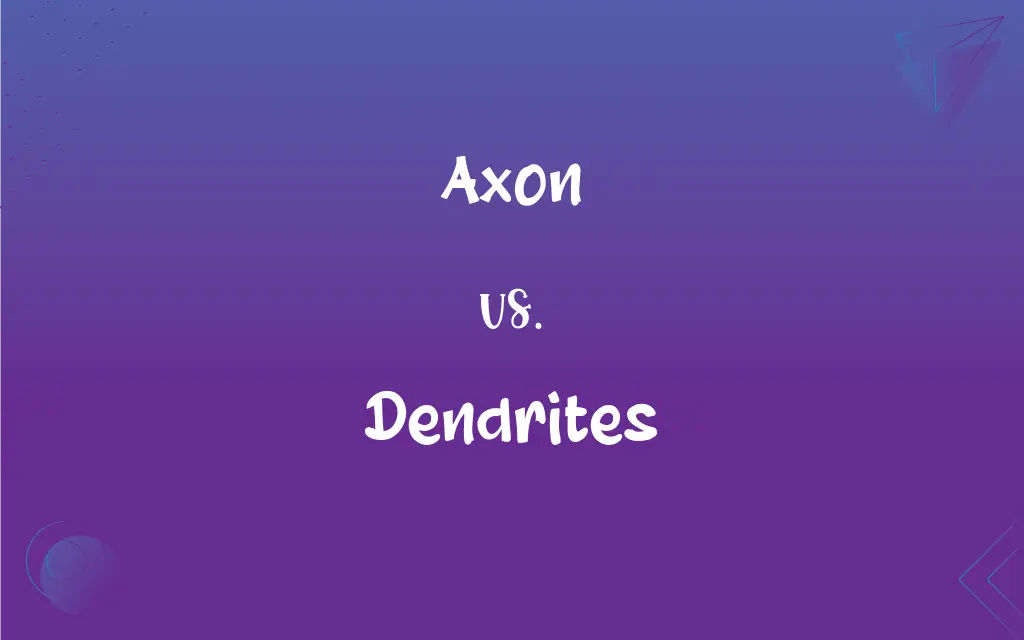Axon vs. Dendrites: What's the Difference?
Edited by Janet White || By Harlon Moss || Updated on October 13, 2023
Axons transmit signals away from the neuron’s cell body, while dendrites receive signals from other neurons.

Key Differences
Axons and dendrites are essential components of neurons, facilitating different roles in neuronal communication. The axon primarily functions to convey electrical and chemical signals away from the neuron's cell body. On the other hand, dendrites, with their tree-like structures, act mainly to receive these signals from other neurons, channeling them toward their own cell body.
In a singular neuron, the axon is typically a single, elongated extension that can project over long or short distances to transmit messages to different parts of the nervous system or to muscles and glands. Conversely, dendrites often exist in numerous extensions, each dedicated to receiving inputs in the form of neurotransmitters from the axon terminals of other neurons, thereby initiating electrical signals within the neuron they belong to.
The structure of axons and dendrites differ significantly, highlighting their differing roles. Axons can be incredibly long (up to several feet in some instances) and are generally covered with a myelin sheath, which serves to speed up the transmission of electrical signals. Dendrites, in contrast, tend to be shorter, are not myelinated, and are branched, optimizing their ability to receive signals from multiple neighboring neurons.
Moreover, the axon ends in synapses, tiny gaps where neurotransmitters are released to signal to the next cell, often in the dendrites of another neuron. Dendrites, having a high surface area due to their branching, accommodate numerous synapses, forming an intricate network through which neurons communicate with each other via axonal signaling.
Lastly, when considering pathology or damage, issues with axons often relate to problems with signal transmission and could potentially affect motor skills and sensory function. Problems with dendrites might manifest as issues in receiving signals, potentially impacting cognitive functions like memory, attention, and perception.
ADVERTISEMENT
Comparison Chart
Function
Transmits signals away from the neuron’s cell body.
Receives signals, usually from other neurons, towards the cell body.
Structure
Typically singular and long, can be myelinated.
Typically multiple, short, and branched; not myelinated.
Direction of Signal
Conduct signals (action potentials) away from the cell body.
Channel incoming signals toward the cell body.
Length
Can be exceptionally long.
Are relatively short.
Role in Neurological Disorders
Often involved in disorders impacting signal transmission and motor function.
Primarily implicated in disorders affecting signal reception and cognitive function.
ADVERTISEMENT
Axon and Dendrites Definitions
Axon
An axon is a neuron’s elongated fiber that transmits electrical impulses away from the cell body.
The axon sends neural signals down to the muscle, triggering a contraction.
Dendrites
Dendrites are branched extensions of neurons, receiving signals from other cells.
Dendrites capture the neurotransmitters released by nearby neurons.
Axon
Damage to axons can disrupt neural signaling and impair motor and sensory functions.
Axon damage in neurodegenerative diseases can cause loss of muscle control.
Dendrites
Dendrites do not have a myelin sheath, unlike axons.
Without a myelin sheath, dendrites predominantly receive and do not expedite signals.
Axon
Axons can be encased in a myelin sheath, enhancing signal speed.
The myelin surrounding the axon accelerates the transmission of neural signals.
Dendrites
Damaged dendrites can impact cognitive functions, including memory and perception.
Diseases affecting dendrites often result in cognitive and perceptual deficits.
Axon
The axon terminates in synapses, facilitating communication between neurons.
Neurotransmitters are released into the synapse at the end of the axon.
Dendrites
Dendrites channel incoming signals towards the neuron's cell body.
The signal travels through the dendrites to reach the neuron’s main part.
Axon
An axon can project to distant or nearby areas within the nervous system.
Pain signals travel along the axon from the injury site to the brain.
Dendrites
They possess multiple branches, maximizing signal reception from adjacent neurons.
Dendrites utilize their branched structure to form numerous synaptic connections.
Axon
The usually long process of a nerve fiber that generally conducts impulses away from the body of the nerve cell.
Dendrites
A mineral crystallizing in another mineral in the form of a branching or treelike mark.
Axon
(cytology) A nerve fibre which is a long slender projection of a nerve cell, and which conducts nerve impulses away from the body of the cell to a synapse.
Dendrites
A rock or mineral bearing such a mark or marks.
Axon
Long nerve fiber that conducts away from the cell body of the neuron
Dendrites
A branched protoplasmic extension of a nerve cell that conducts impulses from adjacent cells inward toward the cell body. A single nerve may possess many dendrites. Also called dendron.
Dendrites
Plural of dendrite
FAQs
What is the main function of dendrites?
Dendrites primarily receive signals from other neurons and direct them toward the cell body.
What is an axon?
An axon is a long, slender projection of a neuron that transmits signals away from the neuron's cell body.
How do neurons regenerate axons after injury?
In certain conditions and particularly in the peripheral nervous system, neurons can regenerate axons through a process that involves axonal sprouting and growth.
What role do axons play in neurodegenerative diseases?
Axons often degenerate in neurodegenerative diseases, impairing signal transmission and leading to symptoms like muscle weakness and sensory deficits.
Are axons always myelinated?
No, axons can be either myelinated or unmyelinated, with myelination enhancing the speed of signal transmission.
How do dendrites process the information they receive?
Dendrites process received information by integrating the incoming signals and generating an electrical response which is sent to the cell body.
How do dendrites communicate with axons?
Dendrites receive neurotransmitters released into the synapse by axon terminals, thereby facilitating inter-neuronal communication.
Can axons receive signals, or only send them?
Primarily, axons are specialized for sending signals, but certain types of neurons exhibit axons that can also receive signals.
How does an axon transmit signals?
Axons transmit signals via electrical impulses, known as action potentials, along their length to other neurons, muscles, or glands.
What happens at the axon terminals?
Axon terminals release neurotransmitters into the synapse, facilitating communication with the dendrites of adjacent neurons.
What is the role of the axon hillock?
The axon hillock is the junction of the axon and the cell body and plays a crucial role in initiating the action potential that travels down the axon.
What is the impact of damaged dendrites on neural function?
Damaged dendrites can disrupt the reception of signals from other neurons, potentially impacting cognitive functions like memory and perception.
How do axons and dendrites contribute to neural circuits?
Axons transmit signals to dendrites of other neurons, forming complex neural circuits that enable coordinated physiological and behavioral responses.
What is the significance of dendritic spines?
Dendritic spines increase the surface area of dendrites, allowing them to form numerous synapses and thus facilitate extensive neural networking.
What is axon guidance?
Axon guidance involves the directed growth of the neuron's axon towards its target, guided by various molecular cues and processes.
How do dendrites and axons maintain neuronal polarity?
Neuronal polarity, with dendrites primarily receiving signals and axons transmitting them, is maintained through specialized structures and distinct molecular compositions in each component, ensuring proper signal flow within neural circuits.
Why are dendrites branched?
Dendrites are branched to maximize the surface area available for making synaptic connections with other neurons.
Why is the myelin sheath important for axon function?
The myelin sheath insulates the axon and accelerates the transmission of electrical signals along it.
Can dendrites regenerate after being damaged?
Dendrites can undergo structural changes and sometimes regenerate after injury, depending on the type and extent of damage.
Can dendrites send signals as well as receive them?
Primarily, dendrites are specialized for receiving signals, though in some cases, they can also send signals to neighboring dendrites.
About Author
Written by
Harlon MossHarlon is a seasoned quality moderator and accomplished content writer for Difference Wiki. An alumnus of the prestigious University of California, he earned his degree in Computer Science. Leveraging his academic background, Harlon brings a meticulous and informed perspective to his work, ensuring content accuracy and excellence.
Edited by
Janet WhiteJanet White has been an esteemed writer and blogger for Difference Wiki. Holding a Master's degree in Science and Medical Journalism from the prestigious Boston University, she has consistently demonstrated her expertise and passion for her field. When she's not immersed in her work, Janet relishes her time exercising, delving into a good book, and cherishing moments with friends and family.































































